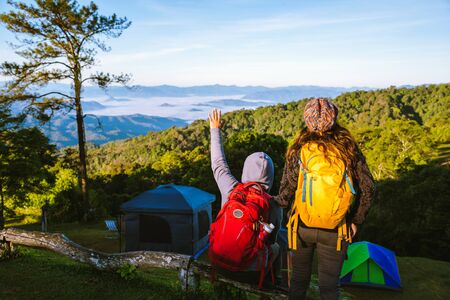1. Overlooking the Importance of Layering
Many campers underestimate the value of layering clothing, which is essential for staying comfortable as temperatures fluctuate throughout the day and night. Whether you’re camping in the mountains, desert, or forest, weather conditions can change quickly—sunny one minute, chilly the next. That’s why understanding how to properly layer your clothes can make or break your camping experience.
Why Layering Matters
Layering helps regulate your body temperature by allowing you to add or remove clothing depending on the weather and your activity level. Instead of relying on one thick coat or hoodie, a good layering system uses multiple pieces that each serve a specific purpose.
The Three-Layer System
Here’s a simple breakdown of the three main layers you should consider when dressing for your next camping trip:
| Layer | Purpose | Common Materials | Tips |
|---|---|---|---|
| Base Layer | Wicks moisture away from skin | Merino wool, synthetic fabrics (like polyester) | Avoid cotton—it holds moisture and makes you cold |
| Mid Layer | Provides insulation and retains body heat | Fleece, down, insulated synthetics | Add or remove this layer based on activity and temp |
| Outer Layer | Shields against wind, rain, and snow | Waterproof jackets, windbreakers, hardshells | Look for breathable and waterproof materials |
A Common Mistake: Wearing Cotton
Cotton might be comfy at home, but it’s not great for camping. When it gets wet—from sweat or rain—it dries slowly and draws heat away from your body. That can leave you feeling cold and uncomfortable, especially at night.
Pro Tip:
Dress in layers even if the weather looks good when you leave. It’s easier to peel off a jacket than it is to warm up after getting too cold.
2. Choosing Fashion Over Function
One of the biggest mistakes campers make—especially beginners—is picking clothes based on style rather than practicality. Sure, that flannel shirt or pair of jeans might look great in Instagram photos, but they can be a real pain when youre out in unpredictable weather or hiking rough terrain.
Why Fashionable Clothes Don’t Work for Camping
Trendy or everyday clothing is often made from cotton or other materials that don’t perform well outdoors. Cotton absorbs moisture and dries slowly, which means if you get wet from rain or sweat, youll stay damp and uncomfortable for hours. That’s not just annoying—it can also put you at risk for hypothermia in cooler temperatures.
What to Wear Instead
Choose performance fabrics designed specifically for outdoor use. These materials are built to handle the elements and keep you comfortable no matter what Mother Nature throws your way.
Recommended Fabric Features
| Feature | Why It Matters |
|---|---|
| Moisture-Wicking | Keeps sweat away from your skin, helping you stay dry and comfortable. |
| Quick-Drying | Prevents you from staying wet after rain, river crossings, or heavy perspiration. |
| Weather-Appropriate | Insulated materials for cold weather, breathable fabrics for heat, and waterproof layers for rain. |
Examples of Good Clothing Choices
- Base Layer: Synthetic or merino wool shirts instead of cotton tees.
- Pants: Nylon hiking pants instead of jeans or leggings.
- Outerwear: Waterproof jackets with breathable membranes like Gore-Tex®.
- Socks: Wool-blend hiking socks instead of regular athletic socks.
Pro Tip:
You don’t have to spend a fortune on name-brand gear. Look for sales at outdoor retailers or check out secondhand shops for quality items at lower prices. The key is choosing function over fashion every time you pack your camping bag.

3. Ignoring the Weather Forecast
Failing to check or prepare for changing weather conditions can quickly ruin a camping trip. Many campers make the mistake of assuming the weather will stay consistent, only to be caught off guard by sudden rain, chilly nights, or strong winds. Not packing the right clothes for these changes can leave you wet, cold, or just plain uncomfortable.
Why It Matters
The outdoors is unpredictable. Even if youre heading out in the summer, temperatures can drop at night or storms can roll in unexpectedly. Wearing cotton in a downpour, for example, will leave you soaked and freezing—plus it takes forever to dry. Windy conditions without proper wind-resistant layers can make even moderate temperatures feel much colder.
How to Avoid This Mistake
Before packing, always check the weather forecast for your camping destination—not just the day you arrive but several days ahead. Look at daytime and nighttime temperatures, chances of precipitation, and wind speeds. Then pack accordingly.
Here’s a quick guide to help you match clothing with common weather conditions:
| Weather Condition | Recommended Clothing |
|---|---|
| Rainy | Waterproof jacket, quick-dry pants, moisture-wicking base layers |
| Windy | Windbreaker or soft-shell jacket, snug-fitting hat |
| Cold Nights | Insulated jacket, thermal base layers, wool socks |
| Hot Days | Lightweight, breathable fabrics; sun hat; UV-protective clothing |
| Variable Conditions | Layered outfits: base layer + mid layer + outer shell |
Pro Tip
Always bring one extra warm layer—even if the forecast looks sunny. Mountains and forests can have microclimates that change fast. Its better to have it and not need it than wish you had packed it when the temperature drops.
4. Wearing Cotton as a Base Layer
One of the most common mistakes new campers make is wearing cotton as their base layer. It might seem like a comfortable and breathable option, but it’s actually one of the worst choices for outdoor activities—especially in cooler or unpredictable weather.
Why Cotton Is a Problem
Cotton absorbs moisture and holds onto it. When you sweat or get caught in light rain, cotton clothing stays wet. This can quickly lead to discomfort, chafing, and in colder temperatures, even hypothermia. Unlike synthetic fabrics or wool, cotton doesnt dry quickly or insulate well when wet.
Better Alternatives for Base Layers
The base layer is your first line of defense against the elements, so choosing the right material matters. Here are some better options:
| Material | Benefits |
|---|---|
| Synthetic (like polyester or nylon) | Wicks moisture away from skin, dries quickly, lightweight |
| Merino Wool | Natural odor resistance, keeps you warm even when damp, soft and breathable |
When Cotton Might Be Okay
If youre car camping in hot, dry weather and not doing much physical activity, cotton might not be a deal-breaker. But for any hiking, backpacking, or cooler climates—leave the cotton at home.
Pro Tip:
A good rule of thumb among seasoned campers is: “Cotton kills.” It may sound dramatic, but it highlights how dangerous wet cotton can be in cold environments. Always check your clothing labels before packing!
5. Neglecting Footwear and Accessories
When planning your camping outfit, its easy to focus only on jackets, pants, or base layers. But forgetting about proper footwear and accessories can turn a great trip into a miserable one. The right shoes and gear protect you from injuries, discomfort, and unexpected weather changes.
Why Footwear Matters
Wearing the wrong type of shoes is one of the most common mistakes campers make. Hiking boots or trail shoes are designed to provide grip, ankle support, and protection against rough terrain. Sneakers or sandals might work for short walks around the campsite but can lead to blisters, slips, or sprained ankles on trails.
Types of Camping Footwear
| Footwear Type | Best For | Avoid If |
|---|---|---|
| Hiking Boots | Long hikes, rocky terrain, wet conditions | You’re staying in a flat, dry campground |
| Trail Shoes | Shorter hikes, mixed terrain | You need ankle support or expect muddy areas |
| Sneakers | Campsite lounging, casual walks | You’re hiking or walking uneven trails |
| Sandals (closed-toe preferred) | Water activities, quick drying needs | You’ll be doing lots of walking or climbing |
The Role of Accessories
A lot of campers forget how important small items like hats, gloves, and extra socks can be. These arent just winter essentials—theyre useful year-round depending on where you camp.
Must-Have Accessories by Season
| Accessory | Why You Need It | Seasonal Use |
|---|---|---|
| Wool or Thermal Socks | Keeps feet warm and dry; prevents blisters | All seasons (choose thickness based on temp) |
| Sunglasses & Hat with Brim | Protects from sun exposure and heatstroke | Mainly summer but also sunny winter days |
| Knit Hat (Beanie) | Keeps body heat in during cold nights/mornings | Mainly fall/winter/spring mornings |
| Gloves (Lightweight or Insulated) | Keeps hands warm; useful for setting up camp in cold weather | Mainly fall/winter but also cool evenings in spring/summer mountains |
Avoiding Common Mistakes
- No backup socks: Always pack extra dry pairs—wet socks can ruin your day.
- Poor shoe fit: Try your boots with the same socks you plan to wear when camping to avoid sizing issues.
- No sun protection: Even in cooler months, UV rays can cause burns. Always bring a hat and sunglasses.
Your feet and your gear keep you moving comfortably outdoors. Don’t overlook them when packing for your next camping trip.


